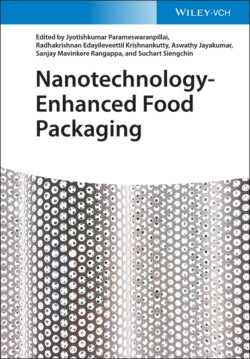Читать книгу Nanotechnology-Enhanced Food Packaging - Группа авторов - Страница 9
Preface
ОглавлениеThe introduction of nanotechnology in food packaging has led to enormous growth in the food packaging industry. Studies have shown that nanotechnology in food packaging can improve the quality and shelf life of food products. The incorporation of organic and inorganic nanomaterials in traditional packaging material has gained much interest due to the enhanced thermomechanical, barrier, and antimicrobial properties. The active packaging and intelligent/smart packaging system offers enhanced features that can extend the quality and shelf life of food products. The active system encompasses the incorporation of antimicrobial agents, preservatives, and gas absorbers, whereas the intelligent/smart system uses chemical sensors, time–temperature indicators, gas sensors, and freshness indicators. The concerns regarding the toxicity, risk, and migration aspects of nanoparticles are also rising; however, these assessments are not still conclusive.
Recently, there is a tremendous increase in the number of research articles and patents in the field of nanocomposites. However, only a few books have been published in the area of nanotechnology-enhanced food packaging. Due to this, we believe it is befitting to judiciously edit a book on Nanotechnology-Enhanced Food Packaging. This book is a collection of chapters with the recent developments in nanotechnological innovations in food packaging. The chapters provide a comprehensive review on types of nanoparticles, their processing, characterization, development of nanoparticle-based packaging systems, and applications. In addition to this, the book discusses the use of nanoparticles in the development of active, smart, and intelligent packaging. We are confident that the present book will benefit researchers working in both academia and industry.
The book includes 15 chapters that cover the recent advantages of Nanotechnology-Enhanced Food Packaging. Chapter 1, “Introduction to Nanotechnology-Enhanced Food Packaging Industry,” discusses an overview of nanotechnology in food packaging. Chapter 2, “An Overview of Biopolymers in Food Packaging Systems,” is designed to give a deep insight into the various biopolymers used in food packaging. Chapter 3, “Nanostructures Based on Starch, Their Preparation, Processing, and Application in Packaging,” deals with starch-based nanostructures, synthesis, and their potential application in food packaging. Chapter 4, “Cellulose Nanostructures and Its Application as Effective Food Packaging Systems,” gives an overview of cellulose, its source, structure, properties, synthesis, and application as food packaging materials. Chapter 5, “Chitosan-Based Nanoparticles and Their Applications in Food Industry,” summarizes an update about chitosan-based nanoparticles and their application in the food industry and packaging. Chapter 6, “Nutrients-Based Nanocarriers and Its Application in Packaging Systems,” summarizes the recent developments in nanocarriers and their application in active food packaging. Chapter 7, “Active Packaging Systems Based on Metal and Metal Oxide Nanoparticles,” emphasizes the recent progress in the application of metal and metal oxide nanoparticles in packaging application. Chapter 8, “Fabrication of Intelligent Packaging Systems Using Nano-Indicators and Sensors,” discusses various nanomaterials-based sensors and their application in intelligent packaging. Chapter 9, “Nanostructure-Based Edible Coatings as a Function of Food Preservation,” discusses the recent developments in nanotechnology-enabled edible coatings. Chapter 10, “An Overview of Higher Barrier Packaging Using Nanoadditives,” highlights the recent developments in higher barrier packaging films with a special focus on gas and moisture barrier properties. Chapter 11, “Nanostructure-Based Multilayer Food Packaging Films,” gives an overview of the various multilayer packaging and their applications in food protection and preservation. Chapter 12, “Characterization Techniques for Nanostructures in Food Packaging,” discusses the various methods used for the development of nanocomposites and techniques used for the characterization of nanostructures in food packaging. Chapter 13, “Biodegradability Assessment of Biopolymer-Based Films,” gives an overview of the biodegradation of biopolymers. Chapter 14, “Nanobiotechnology in Food Preservation and Molecular Perspective,” gives an overview of the use of nanomaterials on food preservation, postharvest storage, and regulation and the safety aspects. Chapter 15, “Environmental and Toxicological Aspects of Nanostructures in Food Packaging,” discusses the various nanoparticles in food packaging, toxicity measurements, migration issues, and environmental impact of nanoparticles.
Thanks to the authors for their contribution.
| 13 April 2021 | Dr. Jyotishkumar Parameswaranpillai (Thailand) | ||
| Dr. Radhakrishnan Edayileveettil Krishnankutty (India) | |||
| Dr. Aswathy Jayakumar (India) | |||
| Dr. Sanjay Mavinkere Rangappa (Thailand) | |||
| Prof. Dr. -Ing. habil. Suchart Siengchin (Thailand) |
